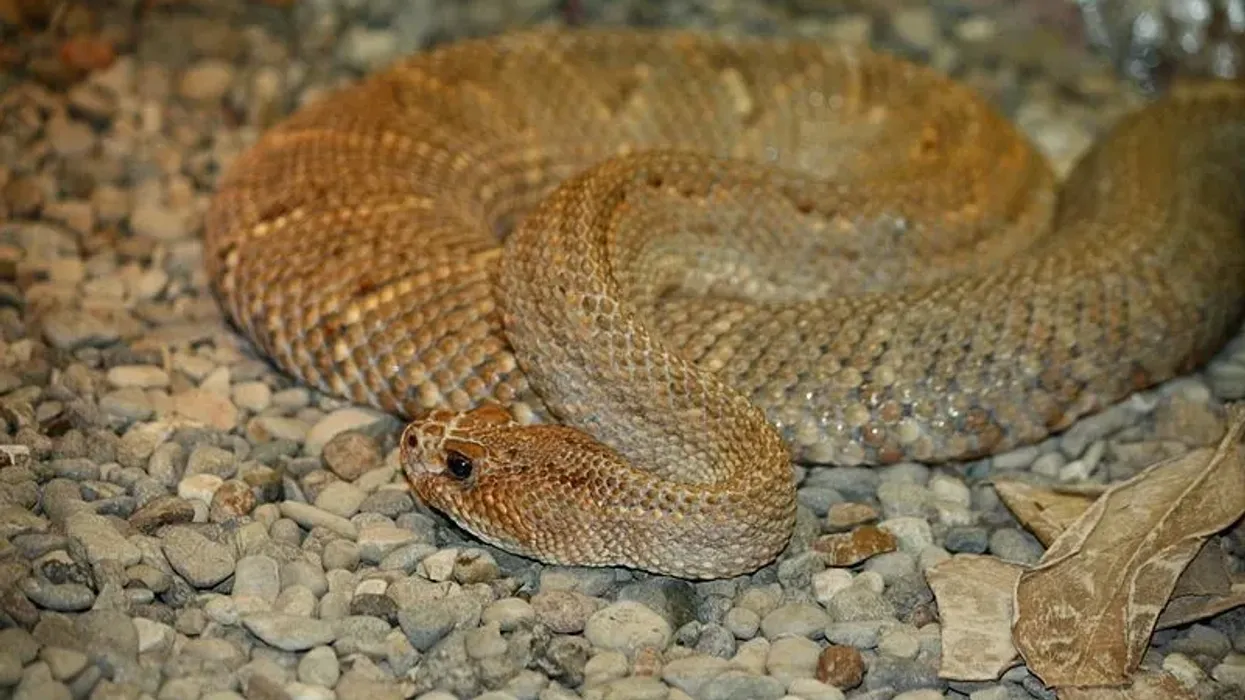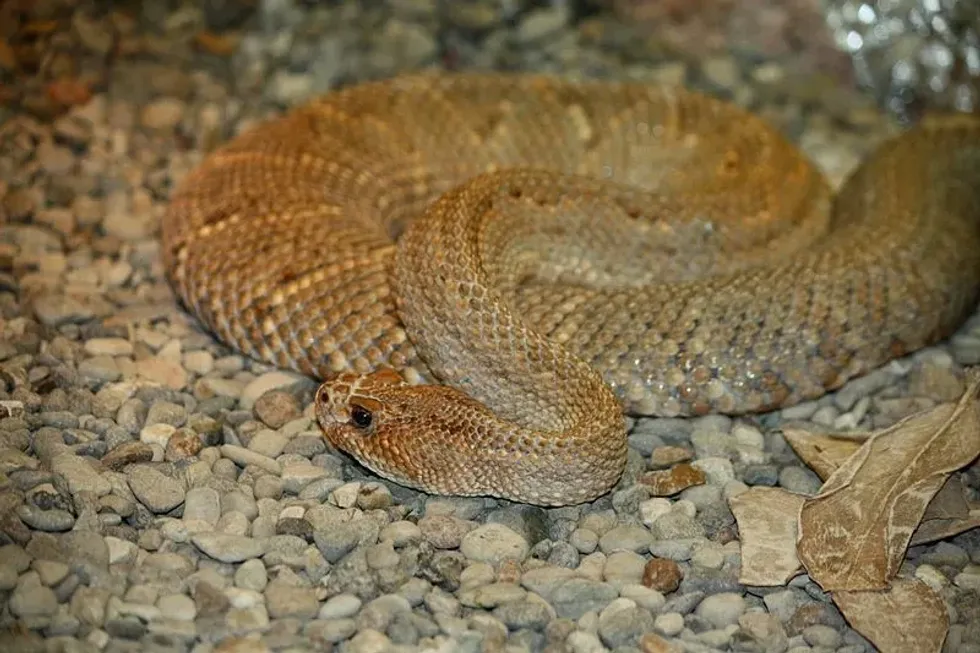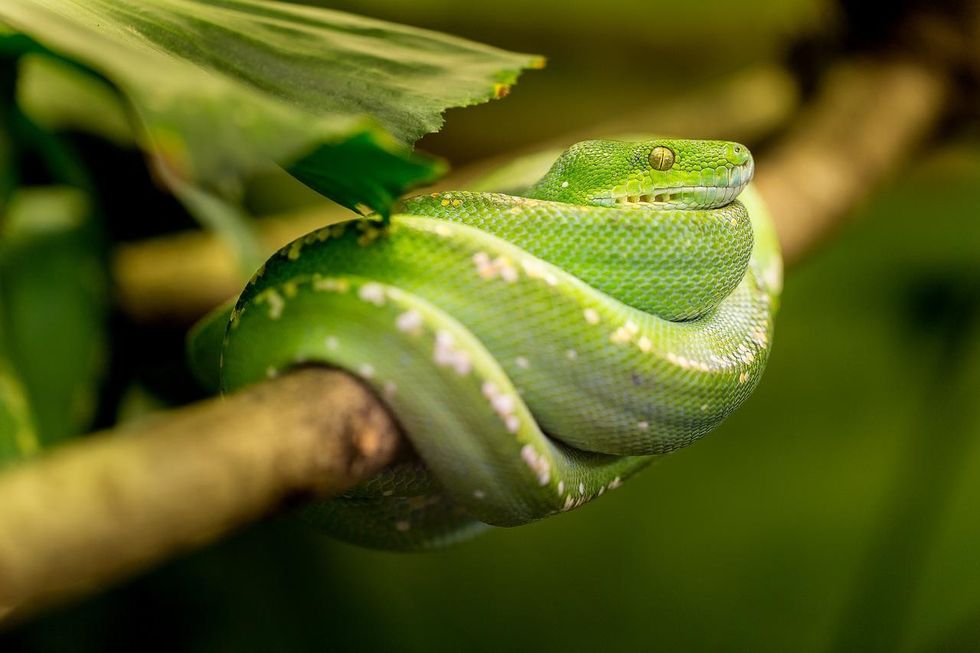The Aruba Island rattlesnake, which has the scientific name Crotalus unicolor, is a species of rattlesnake endemic to the tropical island of Aruba. These snakes are pink to brown in color, with brown or gray markings on their body.
Just like any other rattlesnake, the tail in this reptile also ends with a rattle. They move the tip of their tail in order to produce the rattle sound which warns predators.
These rattlesnakes are found in any dry, rocky, or arid habitat with few people. They have a carnivorous diet and mainly feed on birds, lizards, and rodents.
These snakes are highly venomous and their venom can be fatal. Fortunately, they are not aggressive towards humans and do not strike unless provoked. In Aruba Island, boa constrictors are thought to negatively affect the Aruba Island rattlesnake species.
Apart from that, extensive habitat loss has also led to a decline in the number of Crotalus unicolor in the wild, making them one of the rarest rattlesnakes. Continued research and breeding programs are required to stabilize the population of these vipers.
To know more about the Aruba Island rattlesnake, keep reading! You can also check out midget faded rattlesnake facts and black-tailed scorpion facts.
Aruba Island Rattlesnake Interesting Facts
What type of animal is an Aruba Island rattlesnake?
The Aruba Island rattlesnake (Crotalus unicolor) is a kind of rattlesnake species. These reptiles are one of the rarest rattlesnakes in the wild. The body of this rattlesnake is of medium length with diamond-shaped markings.
What class of animal does an Aruba Island rattlesnake belong to?
The Aruba Island rattlesnake is a member of the class Reptilia. They belong to the family Viperidae and sub-family Crotalinae, which consists of pit vipers.
How many Aruba Island rattlesnakes are there in the world?
The population of Crotalus unicolor is considered to be approximately only 230, making them a very uncommon sight in the natural world.
Where does an Aruba Island rattlesnake live?
The Aruba Island rattlesnake (Crotalus unicolor) is native and endemic to the Island of Aruba. Earlier, their distribution range was throughout the island.
However this has changed and they are now limited to a few square miles or square kilometers of the southern parts of the island due to excessive habitat loss. Out of the 230 Aruba Island rattlesnakes, 110 are kept in captivity by the Association of Zoos and Aquariums (AZA) in the Aruka National Park to bring back their numbers.
What is an Aruba Island rattlesnake's habitat?
The habitat of this snake is characterized by rocky and arid hillsides and terraced mountainsides. These rattlesnakes prefer undisturbed land and inhabit places where the human population is less.
Who do Aruba Island rattlesnakes live with?
Aruba Island rattlesnakes are solitary in nature and are usually seen alone. They do come together for reproductive purposes or for competition to win female snakes.
How long does an Aruba Island rattlesnake live?
These vipers have quite a long life and can live between 12-20 years in the wild and in captivity.
How do they reproduce?
The reproduction in Aruba Island rattlesnakes (Crotalus unicolor) occurs once every year. In this species, mating rituals are extensive and include 'wrestling'.
Once mating is successful, the female rattlesnake undergoes a period of gestation for four months, following which 5-15 offspring are born that remain inside the female rattlesnake. The whole reproduction process is quite an energy-consuming phenomenon for the female because the nutritional burden and increased body weight negatively affect her life.
What is their conservation status?
The conservation status of the Aruba Island rattlesnake (Crotalus unicolor) is Not Evaluated by the International Union For Conservation Of Nature (IUCN). However, in 2007, this rattlesnake was marked as Critically Endangered.
Due to extensive habitat loss, this species is only left with a limited area that is part of their natural range. Breeding programs, research, and plans for introducing legislation to protect this species are underway.
Aruba Island Rattlesnake Fun Facts
What do Aruba Island rattlesnakes look like?
Aruba Island rattlesnakes are quite distinct compared to other species of rattlesnakes, however, they do share a few common features. They have a triangular-shaped head and triangular dorsal scales, which appear to overlap.
At times, a few markings on the head, like two stripes, have also been observed. The color of the body could be light brown, pink, or tan. They have blue-gray, rust, or brown markings on their body which look like diamonds, somewhat resembling the diamond-shaped markings in the species called eastern diamondback rattlesnake.
The markings are not always noticeable except on the spine. Last but not the least, the tail of this snake ends with a rattle.
How cute are they?
To snake enthusiasts, this species of rattlesnakes could be really cute. However, these reptiles are fascinating to everyone as they are one of the rarest rattlesnakes in the world.
How do they communicate?
These snakes use the rattling sound which emerges from their tails to warn off predators. Additionally, pheromones also play a big role in the communication of this species.
Lastly, since the Aruba Island rattlesnake belongs to the pitviper group, they have specialized pit organs. With the help of these organs, they are able to sense body heat and understand their surroundings.
How big is an Aruba Island rattlesnake?
The Aruba Island rattlesnake can grow up to a length of 3.3 ft (1 m). In comparison to other species of rattlesnakes, they are considered to be of moderate size. For example, the eastern diamondback rattlesnake measures 8 ft (2.4 m) and is more than twice the length of the Aruba Island rattlesnake.
How fast can an Aruba Island rattlesnake move?
Though the exact speed of the Aruba Island rattlesnake is not known, members of this family are quite fast. Not only can they travel with great speed, but they also have exceptionally quick strikes. The same can be assumed about this rattlesnake species.
How much does an Aruba Island rattlesnake weigh?
The Aruba Island rattlesnake can gain a weight of nearly 2 lb (1 kg). However, they are much lighter compared to other rattlesnake species like the western diamondback rattlesnake, which weighs between 3-15 lb (1.3-7 kg).
What are the male and female names of the species?
Male and female snakes of this species are known as a male Aruba Island rattlesnake and a female Aruba Island rattlesnake.
What would you call a baby Aruba Island rattlesnake?
Baby Aruba Island rattlesnakes are known as hatchling snakes or snakelets.
What do they eat?
The Aruba Island rattlesnake (Crotalus unicolor) is carnivorous in nature. Their diet includes lizards, birds, and rodents. They position their neck in an 'S' shape before striking prey, by using their two fangs which produce venom.
The venom of this species contains proteolytic enzymes which begin digesting the animals even before they are eaten. Once the prey is dead, the snakes unhinge their lower jaw to swallow their prey successfully. Interestingly, these vipers only feed once or a few times each year.
Are they poisonous?
This rattlesnake species are better described as venomous than poisonous. Their venom contains various kinds of chemicals that help them to kill their prey animals quite easily. Even though these snakes are not aggressive towards humans, a bite from them can result in death.
Would they make a good pet?
It is not legal to own this rattlesnake as a pet. Being one of the rarest rattlesnakes in the world, this species should not be exploited in the pet trade. Additionally, they are a venomous species that is best left alone in the wild in their natural habitat.
Did you know...
The pit organs in the Aruba Island rattlesnake have infrared receptors that allow them to spot and catch their prey even under low light.
Once young Aruba Island rattlesnakes shed their skin for the first time, they start hunting. In general, rattlesnakes shed their skin multiple times in a year.
Other snakes such as the boa and Santanero are found in Aruba Island.
Why is the Aruba Island rattlesnake Endangered?
Aruba Island rattlesnakes are present in a very limited geographical range in the Island of Aruba, making them exceptionally rare in the wild. Unfortunately, their population is primarily threatened by habitat loss.
Apart from man-made causes, like cultivation and tourism development, feral goat populations destroy natural vegetation causing great distress to the population of these rattlesnakes. Boa constrictors in Aruba might also be contributing to the diminishing population range of this species.
Where are rattlesnakes most commonly found?
Rattlesnakes belong to the family of New World vipers. The geographic range of these snakes includes the regions from southern Canada in North America to central Argentina in South America.
However, they are most widespread in southwestern parts of the United States and northern Mexico. The species diversity of these reptiles is most noticeable in these places. They also occur in tropical islands, just like Aruba Island and Santa Catalina Island.
Here at Kidadl, we have carefully created lots of interesting family-friendly animal facts for everyone to discover! Learn more about some other reptiles from our many-banded krait facts and golden tree snake facts pages.
You can even occupy yourself at home by coloring in one of our free printable Aruba Island rattlesnake coloring pages.










